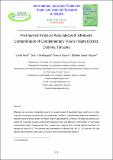Post-harvest Practices Associated with Aflatoxins Contamination of Complementary Flours in Bahi District, Dodoma,Tanzania

View/
Date
2017Author
Aron, Lilian
Makangara, John
Kassim, Neema
Ngoma, Selestin
Metadata
Show full item recordAbstract
Aflatoxins are secondary metabolites produced by several species of Aspergillus fungi, which occur in food
crops due to exposure of pre-harvest and post-harvest conditions. Complementary foods are considered an
important source of energy, protein and fat for children aged between 6-24 months. The study was carried out to
explore the association between post-harvest handling practices and aflatoxins contamination in maize-based
complementary foods. Complementary flour samples were collected from randomly selected household and
analyzed by using HPLC. The presence and concentration of aflatoxins B1, B2, G1, G2 and total AFs was
detected. About 48.95% of all samples were found to be contaminated with aflatoxins. A stepwise linear regression in generalized linear model was used to identify factors that significantly affected
contamination of complementary food with aflatoxins. The analyzed sample was found to be less contaminated
with aflatoxins B1 across all six villages with range of 0.24-1.39 μg/kg, with mean value of 0.67μg/kg and
total mean aflatoxins were found to be 4.79μg/kg. Results indicated that some of the post-harvest handling
practices used by parents/caregivers to agricultural produce used to prepare complimentary food are highly
associated with aflatoxins contamination (p<0.05). The occurrence of total aflatoxin levels in complimentary
flour composite across the six villages was significantly associated with insect infestation, maize/cereals stored
for more than 12 months, drying on bare ground, uses of pesticides to protect stored maize/cereals (p<0.05).
Estimate from the linear regression model indicated that, insect infestation (0.3870), and drying on bare ground
(0.0856) were positively associated with aflatoxins contamination. This study recommends education and
awareness campaign are needed to inform farmers, traders, processors about the risk of fungal growth and toxins
contamination.
